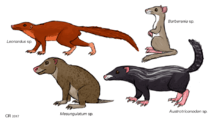Leonardus
| Leonardus | |
|---|---|
 | |
| Leonardus (top left), alongside other meridiolestidan taxa | |
| Scientific classification | |
| Kingdom: | Animalia |
| Phylum: | Chordata |
| Class: | Mammalia |
| Clade: | Cladotheria |
| Superorder: | †Dryolestoidea |
| Clade: | †Meridiolestida |
| Family: | †Leonardus Bonaparte, 1990 |
| Type species | |
| Leonardus cuspidatus Bonaparte, 1990 | |
Leonardus is an extinct mammal genus from the Late Cretaceous (Late Santonian to Maastrichtian) of South America.[1] It is a meridiolestidan dryolestoid, closely related to the also Late Cretaceous Cronopio and the Miocene Necrolestes,[2][3] and potentially also modern marsupial mole.[4]
Description
Leonardus is a fairly small mammal, similar in size to Necrolestes and Notoryctes. It is known from two specimens, the holotype MACN-RN 172, composed of a left maxilla, four associated molariform teeth and two pairs of alveoli, and MACN-RN 1907, a right mandible with two molariforms. Said molariforms are vaguely peg-like, with a dome-like stylocone.
Discovery
Leonardus is currently only known from the Los Alamitos Formation, Argentina. The holotype was found in 1990, while the second specimen was described more recently in 2010.
Classification
Leonardus was originally referred to Dryolestidae, but the lack of a parastylar hook on the molariforms, as well as a few features of the stylocone, suggest that it was grouped with other South American and African dryolestoids at the exclusion of Laurasian species, in a clade known as Meridiolestida.[5] Within Meridiolestida, it consistently groups with Necrolestes and Cronopio.[2][3][4]
Paleobiology
Leonardus' teeth are noted as being fairly specialised, and the animal would have had a somewhat transverse jaw-stroke,[5] though no further comments have been made. It can be inferred that it was either a herbivorous-leaning omnivore like Cronopio or an insectivore like Necrolestes and Notoryctes.
References
- ↑ Leonardus at Fossilworks.org
- 1 2 Guillermo W. Rougier, John R. Wible, Robin M. D. Beck and Sebastian Apesteguía (2012). "The Miocene mammal Necrolestes demonstrates the survival of a Mesozoic nontherian lineage into the late Cenozoic of South America". Proceedings of the National Academy of Sciences of the United States of America. 109 (49): 20053–20058. doi:10.1073/pnas.1212997109.
- 1 2 Alexander O. Averianov, Thomas Martin and Alexey V. Lopatin (2013). "A new phylogeny for basal Trechnotheria and Cladotheria and affinities of South American endemic Late Cretaceous mammals". Naturwissenschaften. 100 (4): 311–326. doi:10.1007/s00114-013-1028-3.
- 1 2 Agnolin, F.; Chimanto, N. (2014-12-22). "Morphological evidence supports Dryolestoid affinities for the living Australian marsupial mole Notoryctes". PeerJ Preprints. 2: e755v1. doi:10.7287/peerj.preprints.755v1. Retrieved 2015-12-30.
- 1 2 Laura Chornogubsky, New remains of the dryolestoid mammal Leonardus cuspidatus from the Los Alamitos Formation (Late Cretaceous, Argentina), Article in Paläontologische Zeitschrift 85(3):343-350 · September 2011 DOI: 10.1007/s12542-010-0095-4